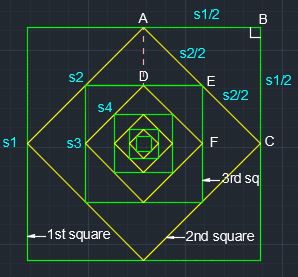
Hopefully, my interpretation of the question is correct. If it is wrong, do let me know. Thank you.
Let s_1,s_2,s_3,s_4,s_5,s_6,s_7,s_8,s_9 be the side length of the 1st square, 2nd square, 3rd square, ..... 8th square, and 9th square, respectively.
Given s_1=6 units.
As can be seen in the diagram,
In DeltaABC, as AB=BC=6/2=3, and angleABC=90^@
=> AC=3sqrt2, => s_2=3sqrt2
=> AE=EC=(3sqrt2)/2
In DeltaADE, as AE=(3sqrt2)/2, and angleDAE=angleDEA=45^@,
=> AD=DE=3/2, => s_3=2*DE=2xx3/2=3
Note that :
s_1=6, s_1/2=3,
s_2=(s1)/2sqrt2=3sqrt2,
s_3=(s_2)/sqrt2=(3sqrt2)/sqrt2=3=s_1/2
As this pattern repeats :
=> s_5=s_3/2=3/2
=> s_7=s_5/2=3/4
=> s_9=s_7/2=3/8
Hence, perimeter of the ninth square =4*s_9=4*3/8=3/2=1.5 units
Footnote : DeltaABC, DeltaADE, DeltaDEF .... are all isosceles right triangles, with angles of 45^@, 45^@, and 90^@, and sides in the ratio of 1 : 1: sqrt2.
